The AMD Radeon RX 5500 XT Review, Feat. Sapphire Pulse: Navi For 1080p
by Ryan Smith on December 12, 2019 9:00 AM ESTPower, Temperature, & Noise
Last, but not least of course, is our look at power, temperatures, and noise levels. While a high performing card is good in its own right, an excellent card can deliver great performance while also keeping power consumption and the resulting noise levels in check.
| Radeon Video Card Voltages | |||||
| 5700 Max | 5500 XT Max | 5700 Idle | 5500 XT Idle | ||
| 1.025v | 1.141v | 0.775v | 0.700v | ||
Back when the RX 5700 series launched, AMD’s voltages surprised me; the RX 5700 XT went as high as 1.2v on TSMC’s 7nm process. For better or worse, it looks like those voltages aren’t a fluke, as we see high voltages with the RX 5500 XT as well. In this case the card tops out at 1.141v, a not insubstantial decrease from the RX 5700 XT, though it’s still relatively high. AMD’s GPUs are still the only high-throughput GPU-like product we’ve seen voltages for on this process, so it’s hard to say whether this is a TSMC thing or an AMD thing. But either way, as AMD’s own voltage/frequency curve helpfully illustrates, the last couple of hundred MHz on the RX 5500 XT gets to be quite expensive in terms of power.
| Radeon Video Card Average Clockspeeds (Rounded to the Nearest 10MHz) |
|||
| Game | 5500 XT | 5700 | |
| Max Boost Clock | 1860MHz | 1750MHz | |
| Official Game Clock | 1717MHz | 1625MHz | |
| Tomb Raider | 1810MHz | 1680MHz | |
| F1 2019 | 1810MHz | 1650MHz | |
| Assassin's Creed | 1750MHz | 1700MHz | |
| Metro Exodus | 1800MHz | 1640MHz | |
| Strange Brigade | 1840MHz | 1660MHz | |
| Total War: TK | 1840MHz | 1690MHz | |
| The Division 2 | 1800MHz | 1630MHz | |
| Grand Theft Auto V | 1830MHz | 1690MHz | |
| Forza Horizon 4 | 1830MHz | 1700MHz | |
Despite that power cost, however, the RX 5500 XT manages to keep its clockspeeds rather high. Even without Sapphire’s higher power cap performance BIOS, their 8GB card is frequently at 1800MHz or better, putting it well ahead of AMD’s official game clock of 1717MHz. This means the card is running fairly close to its clockspeed limit – so Sapphire’s extra power doesn’t do a whole lot – but it also means the card is doing all of this on 130W (or less) of power.
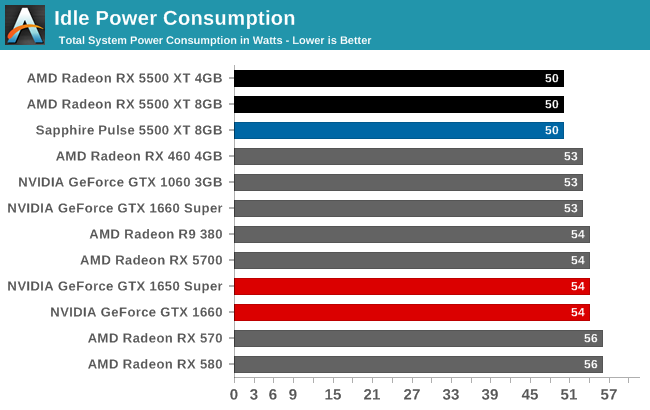
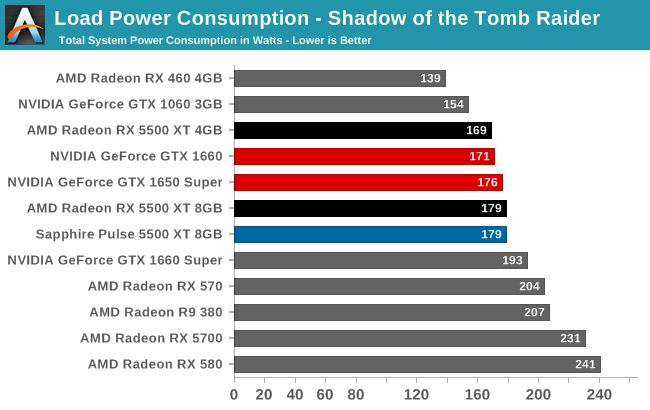
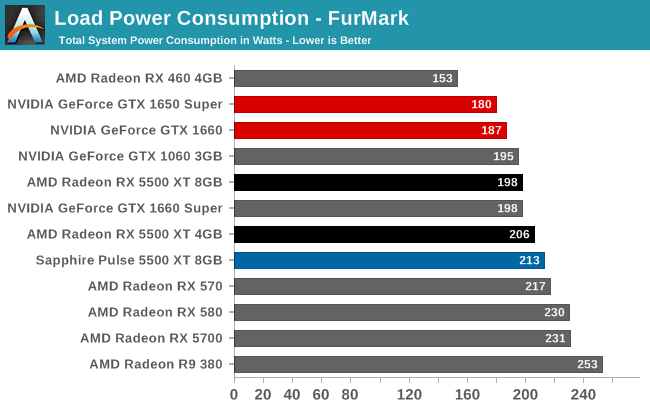
With the combination of TSMC’s 7nm process, AMD’s firmware optimizations, and I suspect the use of just 8 PCIe lanes, the RX 5500 XT fares very well when it comes to idle power. At 50W for the entire system, this is lower than any other configuration by a few watts. Which for idling, where power consumption is already low, is huge. No wonder Sapphire is able to offer zero fan speed idle here; the card is burning very little power at idle.
Similarly, load power is looking fairly good as well. Under Tomb Raider, the total system power consumption with the AMD cards is highly competitive with the NVIDIA competition (though as we’ve seen, actual game framerates trail a bit). Though AMD does fall behind under FurMark, as the 130W+ RX 5500 XT cards all have higher TDPs than NVIDIA’s 120W/125W equivalents, and FurMark will drive all of these cards to their power limits.
In practice, all of this generally reflects the cards’ relative specifications. The RX 5500 XT is able to hang with the somewhat inefficient GTX 1650 Super, however once we get to the more efficient GTX 1660, NVIDIA is consuming less power while delivering better performance.
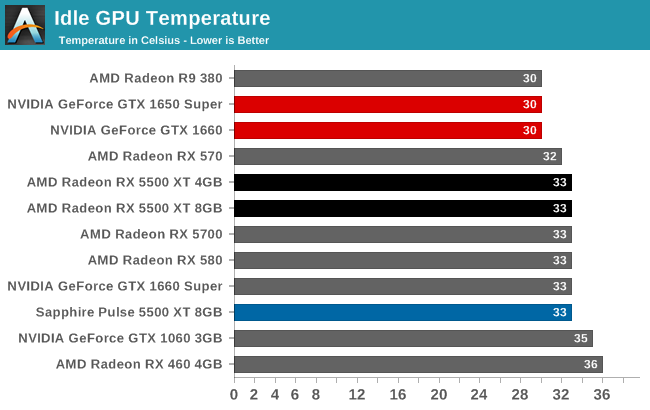


Early on I mentioned that Sapphire’s Pulse cards might be a bit overbuilt, and now that we’re getting into temperature and noise measurements, we get to see why. The idle GPU temperatures are what we’d expect for a zero fan speed idle card; meanwhile the load temperatures don’t crack 70C under Tomb Raider, and even FurMark only pushes the worst card to a well within tolerances 76C.
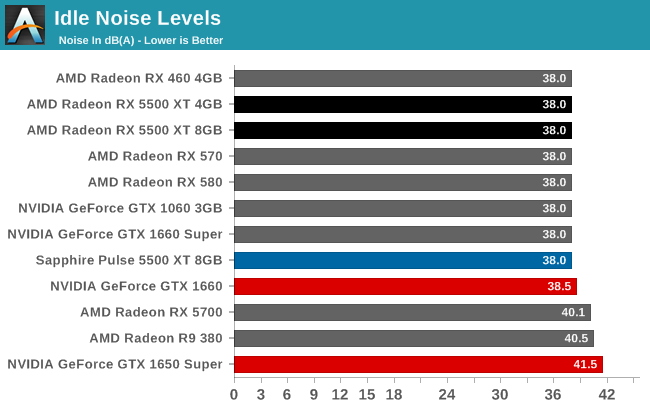
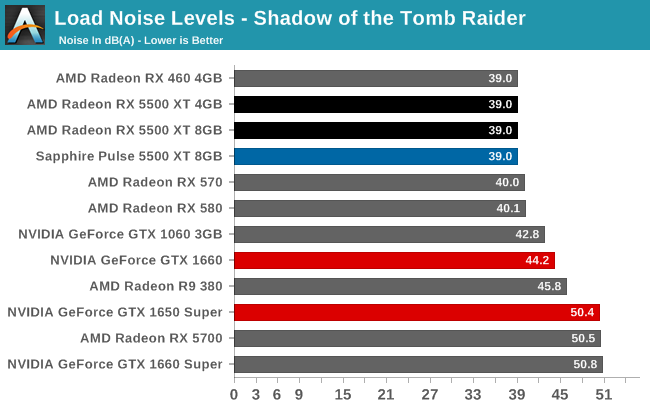
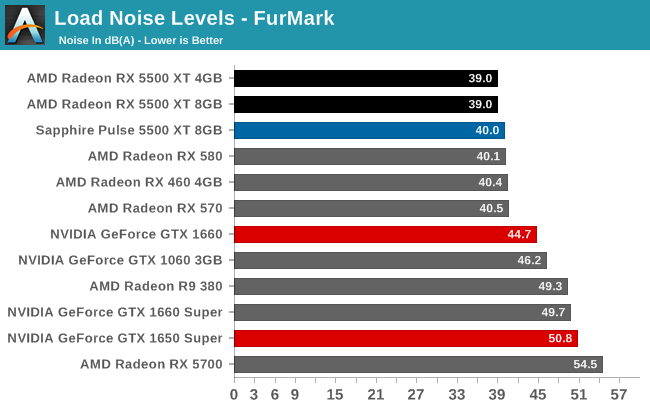
But when we get to noise, this is where Sapphire blows our socks off. Or rather, doesn’t blow our socks off?
The load noise levels I measured here were so low that it required extra effort to properly duplicate the results and isolate noise sources. With a card TDP of 130W, those big 95mm fans end up doing very little work. The PWM and monitoring-enabled fans run at under 800 RPM on gaming workloads, and it’s only when we’re using Sapphire’s higher TDP performance BIOS that the fans crack 1000 RPM.
Sapphire could probably cool a 200W card with this cooler, and I wouldn’t be too surprised to learn that it’s exactly such a card they took it from. But the net result is that while the card is a space hog, it’s a silent space hog. With load noise levels below 40 dB(A) for everything except FurMark, the card is barely louder than the rest of the system. Compared to our GeForce cards, all of which are smaller cards with equally small fans, the difference is extensive. Sapphire may have overbuilt their card, but as a result they’ve struck a great balance between temperatures and cooling performance, and delivering great acoustics in the process.


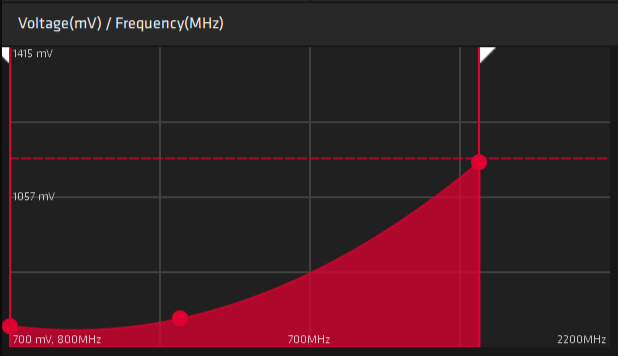








97 Comments
View All Comments
Korguz - Friday, December 20, 2019 - link
and nvidia will price most of their cards out of reach of most people.. like a large chuck of then are now.... do they need to charge that ?? probably not.. but they do... cause they can.. just like intel before zen...Kangal - Friday, December 20, 2019 - link
Not quite.Before, in the early 2000-2005 period the Internet was not as accessible and pronounced as it is today. And to add to that, when it came to "perception" things like marketing were very effective. So despite AMD producing some of the best CPUs and GPUs at the time, they weren't winning. Intel and Nvidia had the mindshare, thanks to their large marketing departments.
Now?
There's Facebook and YouTube. Information is much more accessible, anyone can find more details about a product from more trusted third-party professionals. And on top of that, the past few years has changed the public's mindshare about AMD. They're now seen as the better CPU company, so that trickle downs to their perception of GPUs as well. It is no longer a "poor mans Nvidia".
So what am I saying?
The more things change, the more they stay the same. The market will always have winners and losers. However, this time AMD is under new management and heading a new direction, and they have seized a real opportunity to turn things around. That might mean AMD only releasing a few cards, and instead focusing their attention to things that make money: servers and consoles. I'm fine with that, and if things kind of sour, well it was the (sheep) public's fault for allowing the monopoly to arise by not being more critical and skeptical (think pre-1950's attitude). However, I should also add that just because there is a monopoly does not mean the market isn't healthy or competitive or that it's bad for the consumer; it is likely to be the case but not a certainty.
Korguz - Friday, December 20, 2019 - link
nvidia had the mindshare.. but intel has its bribes and threats....either way.. unless amd can make a zen2 equivalent for radeon, nvidia will still over charge and price some of their cards out of reach of most people, like they already have done
Gemuk - Thursday, December 12, 2019 - link
I'd argue that it wasn't AMD selling RX 570 and RX 580 for cheap that has distorted the market, rather it was the consumer's acceptance of the higher pricing across the board. Price/perf needle has barely moved up after three years. It is the new norm. We're never going back to those days, are we?Yojimbo - Thursday, December 12, 2019 - link
Price/performance has moved up since 3 years ago. 3 years ago a 1060 cost about what a 1660 Ti costs now, and a 1660 Ti is about 36% faster than a 1060. You are getting over 30% increase in performance per price, even if you throw out what happened to 1060 prices because of the crypto craze and spike in DRAM prices. The gain in performance per dollar from the 960 to the 1060 was about 44%. So it's lesser this generation but I don't think the difference qualifies as "barely moved up" and you can't take one example and call it a trend. As for the RTX cards, of course with NVIDIA taking up die space on new features that don't go into price/performance calculations there is going to be a drag on the numbers that get spit out.AMD were selling the 570 and 580 for cheap because they had a bunch of them in inventory from the crypto hangover and they needed to get as much revenue for them as they could. If it took too long they would lose more value and they'd have to delay the 5500.
Alistair - Thursday, December 12, 2019 - link
you mean 1660 super is the same price as the 1060, the 1660 ti is still more expensive than the old 1060 from years agojabbadap - Thursday, December 12, 2019 - link
gtx1060 FE 6GB msrp was $299 same as gtx1660ti. While gtx 1060 6GB has "msrp" of $250, finding AIB sku priced as such was near to non-existent. Norm was $299 and more like gtx1660tis.1660 Super is $229, which is lower than any official price point nvidia gave to gtx1060 6GB cards.
HardwareDufus - Thursday, December 12, 2019 - link
Had one of my 24" 1920x1200 monitors fail the other day, and the other has a few lines. Therefore, I purchased 2 32" 4K monitors. Should arrive in days.Thinking about purchasing a discreet video card as my current I7-3770K with its IGP won't drive these new moniros to 4K resolutions.
I don't game, so I would imagine I'd received satisfactory performance with an inexpensive 5500XT card to drive both these monitors at 4K for really good size/readability of text?
Comments?
haukionkannel - Thursday, December 12, 2019 - link
For that usage... sure. But no Gaming unles you use 50% scaling. With 50% scaling and amd sharpening, even Gaming is good.Zoomer - Saturday, December 21, 2019 - link
Don't need sharpening with 50% scaling. Pixels will just be 4 times as big and map perfectly.